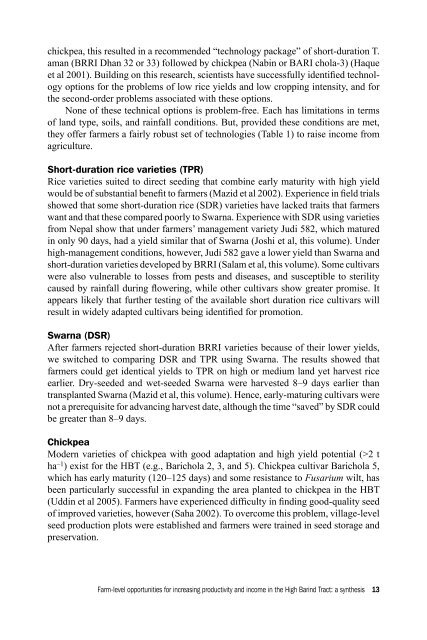Download (2461kB) - University of Greenwich
Download (2461kB) - University of Greenwich
Download (2461kB) - University of Greenwich
- No tags were found...
Create successful ePaper yourself
Turn your PDF publications into a flip-book with our unique Google optimized e-Paper software.
chickpea, this resulted in a recommended “technology package” <strong>of</strong> short-duration T.aman (BRRI Dhan 32 or 33) followed by chickpea (Nabin or BARI chola-3) (Haqueet al 2001). Building on this research, scientists have successfully identified technologyoptions for the problems <strong>of</strong> low rice yields and low cropping intensity, and forthe second-order problems associated with these options.None <strong>of</strong> these technical options is problem-free. Each has limitations in terms<strong>of</strong> land type, soils, and rainfall conditions. But, provided these conditions are met,they <strong>of</strong>fer farmers a fairly robust set <strong>of</strong> technologies (Table 1) to raise income fromagriculture.Short-duration rice varieties (TPR)Rice varieties suited to direct seeding that combine early maturity with high yieldwould be <strong>of</strong> substantial benefit to farmers (Mazid et al 2002). Experience in field trialsshowed that some short-duration rice (SDR) varieties have lacked traits that farmerswant and that these compared poorly to Swarna. Experience with SDR using varietiesfrom Nepal show that under farmers’ management variety Judi 582, which maturedin only 90 days, had a yield similar that <strong>of</strong> Swarna (Joshi et al, this volume). Underhigh-management conditions, however, Judi 582 gave a lower yield than Swarna andshort-duration varieties developed by BRRI (Salam et al, this volume). Some cultivarswere also vulnerable to losses from pests and diseases, and susceptible to sterilitycaused by rainfall during flowering, while other cultivars show greater promise. Itappears likely that further testing <strong>of</strong> the available short duration rice cultivars willresult in widely adapted cultivars being identified for promotion.Swarna (DSR)After farmers rejected short-duration BRRI varieties because <strong>of</strong> their lower yields,we switched to comparing DSR and TPR using Swarna. The results showed thatfarmers could get identical yields to TPR on high or medium land yet harvest riceearlier. Dry-seeded and wet-seeded Swarna were harvested 8–9 days earlier thantransplanted Swarna (Mazid et al, this volume). Hence, early-maturing cultivars werenot a prerequisite for advancing harvest date, although the time “saved” by SDR couldbe greater than 8–9 days.ChickpeaModern varieties <strong>of</strong> chickpea with good adaptation and high yield potential (>2 tha –1 ) exist for the HBT (e.g., Barichola 2, 3, and 5). Chickpea cultivar Barichola 5,which has early maturity (120–125 days) and some resistance to Fusarium wilt, hasbeen particularly successful in expanding the area planted to chickpea in the HBT(Uddin et al 2005). Farmers have experienced difficulty in finding good-quality seed<strong>of</strong> improved varieties, however (Saha 2002). To overcome this problem, village-levelseed production plots were established and farmers were trained in seed storage andpreservation.Farm-level opportunities for increasing productivity and income in the High Barind Tract: a synthesis 13
















